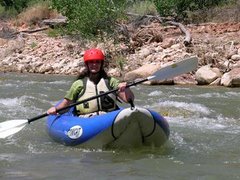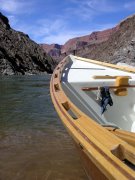Tanya and I have all the paperwork and $ in now and have started
getting all the logistics and equipment together. I have all of our
equipment ready to start stuffing into our 6 drybags, minus the
drysuits and a couple other amenities. On the 17th The trip leader and others will come to SG,and we will do our "Costco" shopping spree.
We drive to Lees Ferry for the mandatory Park Briefing and assistance
rigging and packing boats, and introductions and hellos on the
afternoon of Feb. 27, then return home for 10 days. We then will
drive to Flagstaff on the 9th and spend the night, awaiting our
shuttle to Yaki Point for the hike to Phantom in the morning. On the
RIVER from 2PM on March 10th until March 21st or 22nd where we will
swap keys with Larry Stevens who so generously will have my vehicle
awaiting at Whitmore Wash by Bar 10.
I must sound like a "Kid at Christmas"? I am super stoked for this
and know this is a trip of a lifetime! Hope to have some tales to
tell and pictures to show !
- Bo
Jan Taylor from the Grand Canyon Yahoo Group, who is an avid river runner in the Grand Canyon has offered a great list of things to take.
Suggested Equipment for Grand Canyon Rafting
by Jan Taylor
Plan to pack only as much as can fit into one-and-a-half paper grocery bags. This is approximately the size of a standard dry bag provided by rafting outfitters unless you supply your own. Do not bring a duffel bag on the river. The dry bag will be provided either at Lees Ferry for transferring your gear or the night before at the assembly meeting, depending on how your outfitter makes the arrangements. If you have to transfer gear into a dry bag at Lees Ferry, have it ready in a doubled-up heavy duty plastic garbage bag. A day dry bag will also be provided for the things you’ll need during the day (e.g., day pack, rain gear, jacket, etc.).
Clothing:
- Quick dry shorts (1 or 2 depending on your personal preference) – synthetic, not cotton.
- Quick dry pants (1 or 2) – synthetic, not cotton.
- Bathing Suits (1 or 2), 2-piece for women, such as a tankini – this is helpful when bathing or for “bathroom” use.
- Long sleeve quick dry shirt for sun protection. Cotton is OK for the summer since it can be soaked for cooling and will take longer to dry. In cooler weather cotton is to be avoided because it stays cold and wet.
- Bandanas – wet down and wrap around your head/neck to keep cool in hot weather.
- Fleece jacket (not cotton) for layering under rain gear and for cool nights.
- Medium or light weight base layer (long underwear) for summer – fleece, Capilene, or Polypropylene, and a vest (for cooler weather). Expedition or medium weight base layer for winter or spring. These are to wear under rain gear, sleepwear, or in camp if it’s cold.
- Fleece pants for winter or spring, either medium or expedition weight. If the weather is colder, expedition weight is recommended. Keep in mind that GC weather can be unpredictable, even in the summer.
- River sandals (e.g., Tevas, Merrills, Chacos). Since you may be doing some hiking in the sandals, they should have good traction. Sand and water work against the effectiveness of Vel-cro. Opt for good fitting sandals with good support. Neoprene river/dive booties are a good alternative for use on the boat.
- Light weight hiking boots that you don’t mind getting wet. Make sure they are broken in ahead of time. Tennis shoes stay wet and don’t have good traction when hiking, so should be avoided.
- Light weight wicking hiking socks. Fleece socks for camp if it’s cold. Waterproof socks (e.g., SealSkinz) with warmer sock liners are good for the boat during cold weather.
- Fleece or Polypropylene gloves, especially for winter or spring. Waterproof gloves (e.g., SealSkinz) with glove liners are good for the boat during cold weather.
- Hat – large brim, quick dry material because it will get wet (not wool – absorbs too much water and takes too long to dry). This is an essential item in the summer when the temperatures can get to 1200. It should have a chin strap or clip-on retainer because the wind can be fierce. I prefer a baseball-type cap. I loop my sunglasses retainer through the back of the cap to prevent it from being blown or washed away.
- Rain gear (no plastic or ponchos) – at least a jacket for summer, jacket and pants for spring and winter. This is essential at any time of the year. Look for sealed seams, breathable material (non-breathable material is less expensive, but can be stifling in the summer), and gaskets at the neck, wrists, waist, and ankles to keep freezing water out.
- T-shirts or other loose and comfortable clothing to wear around camp or on hikes.
- Flip-flop sandals in summer to wear around camp, although this isn’t essential.
Additional Items:
- Day pack lined with a plastic garbage bag to store day use items on the boat while on river (hiking boots and socks, fanny pack or Camelback, rain gear, long sleeve shirt, etc.). Some outfitters provide an ammo box for boat use, or a day use dry bag.
- 2 locking carabiners to secure day pack or day use dry bag on the boat.
- Camera equipment – essential item. You will be taking lots of pictures. In addition to a regular camera and film, a couple of waterproof disposable cameras is a good idea to take pictures while going through rapids. It’s a good idea to have a waterproof camera bag or hardshell case (e.g., Otter Box) for the non-waterproof equipment. Digital cameras are becoming quite popular.
- Binoculars – small, waterproof is preferred.
- Water bottles or self-contained hydration system – 3 quarts recommended. I keep a Camelback in my day pack, plus a water bottle right by me secured to the boat with a strap.
- Sunglasses with retainer. It’s a good idea to bring an extra pair of sunglasses. UV protection is highly recommended.
- Sun Shower (optional) – at least 2.5 gallons for sufficient warm water. This does take up some space, so check with the outfitter to see if they recommend bringing one or not.
- Towel – small to medium pack towel.
- Moisturizing lotion, alcohol free. This is essential. The air is very dry and cracked fingers and feet are painful and not uncommon. No-Crack lotion is often used by river guides.
- Headlamp or flashlight. A headlamp is helpful because it leaves your hands free – a good thing for navigating to the river or portapotty in the middle of the night. The LED kinds are lightweight and powerful.
- Extra batteries for the headlamp/flashlight and camera. If your equipment uses only rechargeable batteries, you will need a solar battery charger. There are no electrical outlets available.
- Eye glasses/contact lenses plus lens cleaner and saline solution if needed. An extra pair of reading glasses to keep in the dry bag is a good idea.
- Biodegradable soap (for bathing and washing clothes) and shampoo/conditioner.
- Hair brush, hair clips, ponytail holders.
- Toothpaste, toothbrush, dental floss, nail clippers, tweezers, feminine hygiene products, Q-tips, tissues, deodorant. Bring plenty of feminine hygiene products if you are of that persuasion, plus small zip-lock bags for refuse if you need to change during a hike. EVERYTHING packed in must be packed out.
- Waterproof sunscreen and lip balm – bring plenty.
- Aloe vera gel for soothing sunburns.
- Band-Aids, New-Skin, waterproof adhesive tape, blister pads, duct tape (for large areas that need good coverage). Some of this will be available in the first aid kit on the boats, but it’s a good idea to have plenty available. Most people get raw spots on their feet when sand gets between the sandal straps and skin, so bring more Band-Aids and adhesive tape than you think you could possibly need. Band-Aids usually lift when wet, even the waterproof kind, so plenty of waterproof adhesive tape is a must.
- Medications, vitamins, insect repellent (with DEET), Sting-Eze (for instant relief from bug bites), Epi-Pen (if you have severe allergies to bug bites), glucose monitoring kit (for diabetics), and Imodium for possible diarrhea.
- Chemical hand and toe warmers.
- Light weight rope or cord for securing your tent and for a clothesline, plus clothespins.
- Book, journal, pens/pencils, river guide book..
- Travel Pillow – this is optional. Rolling up a jacket or other clothing works just as well.
- Garbage bags, Zip-lock bags, heavy duty/freezer bags.
- Pocket knife
- Inflatable fold-up or roll-up camp chair (e.g., Crazy Creek or Slumber Jack), or a small Roll-A-Chair.
- Wet wipes for quick clean-up if you object to bathing in 47o water.
- Platypus-type transparent bladders (flexible bottles) for your favorite beverages not provided by the outfitter.
- Frisbee (optional).
- Money for incidentals at Phantom Ranch or a road stop on the return trip, and gratuities for the guides ($10 per day per passenger is typical, but this is a personal choice).
- Optional – fishing gear (a fishing license is required) and musical instruments (alert the outfitter ahead of time so they can provide a waterproof bag).
- Marking pen, and masking tape – good for a variety of uses including labeling your garbage bags and making quick repairs.. Most garbage bags look alike.
- Bubbles – for fun on the river if you are so inclined. Hawaiian shirt, nail polish, tatoos.
- Colored yarn for marking your dry bags and tent bag since they all look alike.
Items Typically Provided by the Outfitter:
- Dry bags (for clothing and sleeping gear).
- Day dry bag for items to have with you during the day
- Sleeping gear (sleeping bag, padded/inflatable sleeping pad, ground cloth, sheet/liner)
- Ammo box or day use dry bag for items to have handy on the boat
- Mug, plate, and eating utensils
- Guide book – some outfitters provide this as part of the trip, others offer a book for sale.
- Tent – sometimes offered for rent, sometimes provided at no charge. This is recommended since weather can be unpredictable during the winter and spring. Monsoon season is July and August, so rain is likely. There is no place like the Grand Canyon for sleeping under the stars, though, when it isn’t raining.
-- Jan Taylor
The Grand Canyon North Rim is spectacular, pristine and remote. These characteristics make it a wonderful place to visit, but at the same time keep the huge populations out that visit the South Rim. The North Rim offers everything the South Rim does except the crowds. Some of the most incredible views of the Grand Canyon are at the North Rim, Toroweap and even from the Kaibab National Forest. This blog will focus on the North Rim, South Canyon, Toroweap and the Forest.
Grand Canyon

Tanya Kayaking
About Me
Grand Canyon

River Trip
